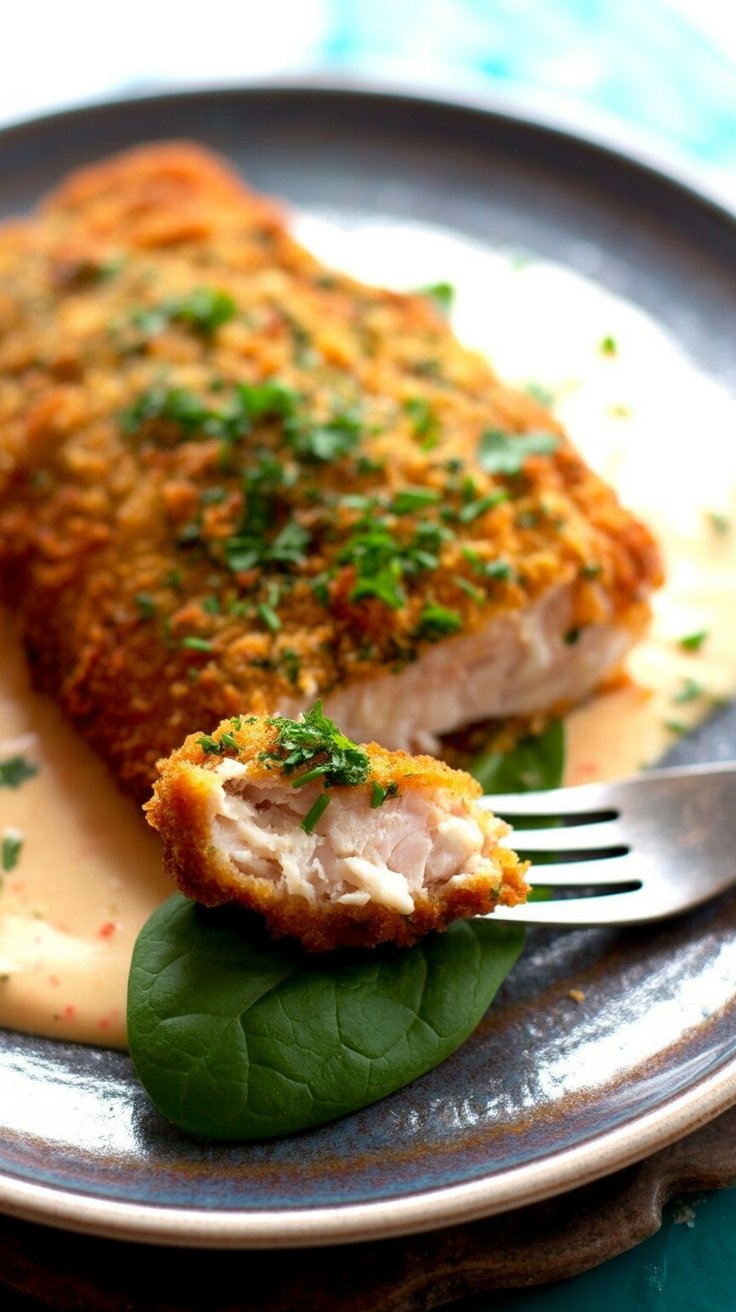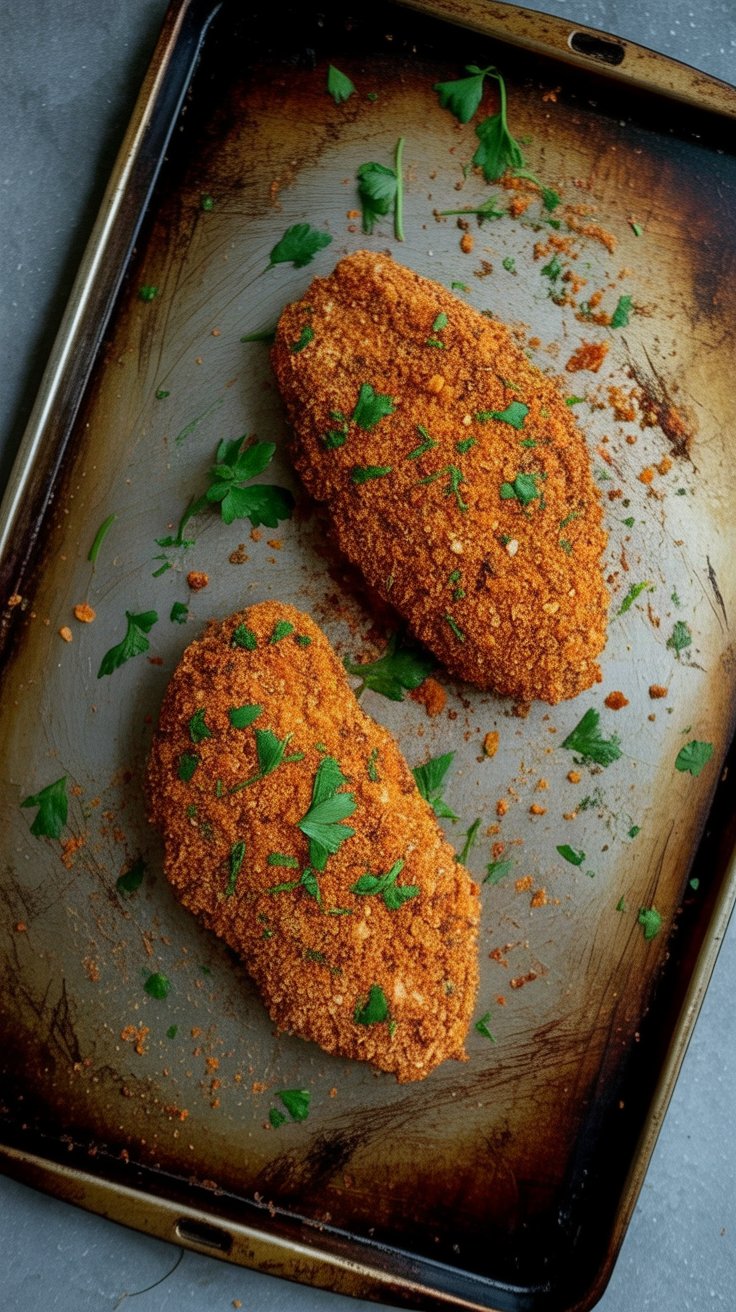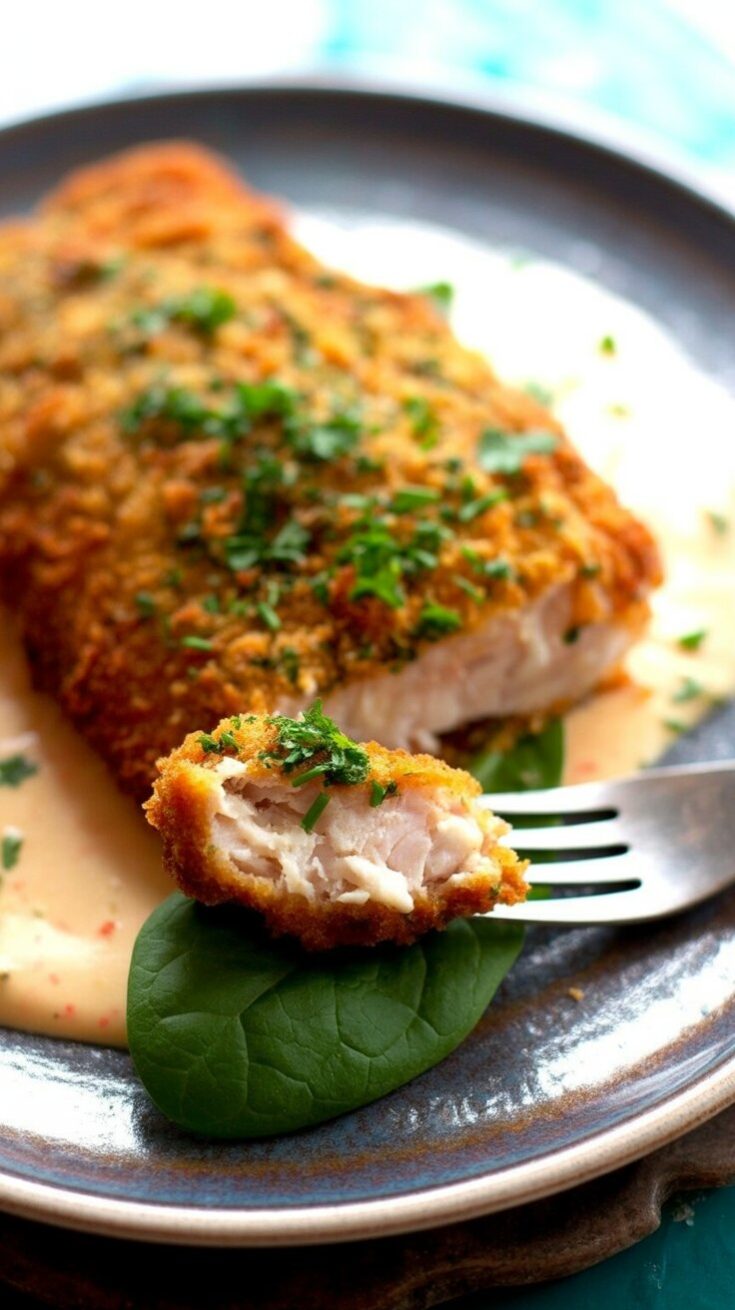There’s a certain comfort in dishes that feel rooted in quiet evenings at home. This baked catfish with a pecan crust is one of those meals I return to over and over. It has the kind of warmth that reminds me of the food I grew up around, yet the light lemon butter on top gives it a gentle brightness that makes it perfect for both a casual weekday dinner and a meal you linger over on a slow weekend afternoon. Every time I make it, I’m reminded of how a simple idea can turn into something I cook for years.

How This Dish Became a Staple in My Kitchen
My fondness for this recipe comes from a trip early in my cooking days. I remember stepping into a restaurant during a short getaway, tired from walking and ready for something comforting. The fish I ordered came with a pecan topping that added sweetness, crunch, and a little touch of something special. I didn’t expect it to leave such an impression, but the flavors stayed with me long after the trip ended.
Back home, I tried recreating the dish using different methods. The original version I first tasted was made with more butter than I wanted to use for everyday cooking, so I slowly shaped my own approach. Baking the fish instead of pan-frying gave me better control over the nuts, and it made the whole process calmer — the kind of meal I can pull together while chatting with family or tidying the kitchen. Over time, this became one of those recipes that feels like second nature.
What This Style Brings to the Table
The traditional preparation usually involves flour, butter, and a quick pan-fry. It’s lovely, but nuts like pecans can turn dark very quickly on the stovetop, and I’ve had my fair share of batches that browned faster than I expected. Baking gives the nuts a slow, gentle toast that lets them stay crisp without turning bitter.
The fish itself turns tender and flaky, and once the lemon butter flows across the crust, everything comes together in a way that feels both light and full of flavor. I often think of recipes like this as the kind of thing you serve when you want dinner to feel relaxed but still thoughtful.

Helpful Notes and Kitchen Habits That Always Work for Me
After many rounds of making this dish, these are the habits I rely on:
-
Keeping the pecans textured: I use my food processor in short pulses. I stop as soon as the nuts look evenly chopped. A smooth paste won’t give the fish that crunchy top, so I keep everything on the coarse side.
-
Picking the right fish: I choose catfish with a clean, mild taste. If someone at the table prefers something different, I swap in tilapia or flounder. I’ve even done this with chicken breast cut into thin strips, and the pecan crust still worked beautifully.
-
Adding a little heat: A pinch of spice in the nut mix wakes up the whole dish. It doesn’t overpower anything — it just makes every bite a bit more interesting.
-
Preparing the sauce gently: Light butter melts quickly, and it gives the sauce a soft texture. I warm it just enough to blend with the lemon, which keeps the flavor fresh.
A Side Dish That Fits Perfectly
I’ve always liked pairing fish with greens because they bring a balance that feels satisfying. My kitchen almost always has kale, chard, or spinach on hand, so I reach for whatever looks good that day. I toss the greens into a warm skillet with garlic, a little crushed pepper, and a splash of vinegar. That one adjustment — the vinegar — gives the greens a brightness that lifts the whole dish.
There are days when I make a full plate, with the fish resting on top of the greens so the lemon butter runs through everything. On rushed nights, I serve the greens and fish separately and let everyone mix things as they like. Either way, the combination never fails.
Practical Storage Notes from My Humble Home Kitchen
This dish keeps well, and it’s one of the few fish recipes I don’t mind eating the next day. If I expect leftovers, I keep the sauce in a separate container so the crust stays firm. With reheating, the oven is my friend — a slow warm-up keeps the pecans crisp. The greens reheat much faster, and I often refresh them with a quick squeeze of lemon.

FAQs
Can I prepare the pecan mixture ahead of time?
Yes. I often chop the pecans and mix the seasoning earlier in the day. I keep the mixture covered and dry until I’m ready to coat the fish.
What other fish can stand in for catfish?
Flounder, sole, barramundi, or tilapia all fit well with this style. They each offer a mild taste that lets the pecans shine.
Is fresh lemon necessary for the sauce?
Fresh lemon makes a noticeable difference. Bottled juice works in a pinch, but the flavor is sharper with fresh lemon.
Can I lower the heat in the greens?
Of course. If crushed pepper feels too strong, leave it out and rely on garlic and vinegar for flavor.
Can I prepare the fish earlier in the day and bake later?
Yes, but I keep the coating separate until just before baking to keep the crust crisp.
Baked Catfish Pecan Meuniere and Spicy Sauteed Greens

This baked catfish brings together a crisp pecan coating, a bright buttery sauce, and a side of warm, spicy greens
Ingredients
For the Catfish
- 2 (6–8 oz) catfish fillets rinsed and patted dry
- 1 cup pecans
- 1 tablespoon milk
- 1 large egg
- Salt and freshly ground black pepper to taste
- 2 teaspoons Cajun seasoning
- 1/2 teaspoon cayenne pepper or to taste
- 1/4 cup all-purpose flour
- Cooking spray
For the Meuniere Sauce
- 1/2 cup light butter
- 2 teaspoons lemon juice
- 1 teaspoon Worcestershire sauce
- Hot sauce to taste
- 2 tablespoons chopped parsley plus a little extra for garnish
For the Greens
- 2 tablespoons olive oil
- 1–2 bunches Swiss chard or other greens such as kale, spinach, turnip greens, or collards cut into strips
- 3 cloves garlic minced
- 1/2 teaspoon crushed red pepper flakes
- 1 tablespoon red wine vinegar or to taste
- Salt and freshly ground black pepper to taste
Instructions
- Set the oven to 375°F and lightly coat a baking dish with cooking spray.
- Pulse the pecans with salt, pepper, Cajun seasoning, and cayenne until they form fine crumbs, then spread the mixture onto a plate.
- Place the flour on a second plate and season it lightly. Whisk the egg and milk together in a shallow bowl.
- Coat each catfish fillet in the seasoned flour and shake off the excess. Dip the fillets into the egg mixture, then press them into the pecan coating until fully covered. Arrange the fillets on the prepared baking dish and mist the tops with cooking spray.
- Bake until the fish flakes easily when tested with a fork, about 18–20 minutes.
- To make the sauce, warm the butter, lemon juice, Worcestershire, and hot sauce in a small saucepan over low heat until the butter has melted. Stir in the parsley and keep warm.
- For the greens, heat the oil in a skillet over medium-high. Add the greens in batches, tossing with tongs as they wilt so you can fit more into the pan. Stir in the garlic and cook briefly until fragrant, then mix in the red pepper flakes, vinegar, and a light seasoning of salt and pepper.
- Serve the baked catfish over the warm greens and spoon the meuniere sauce over the top. Adjust seasoning before serving if needed.
Nutrition Information
Yield
2Serving Size
1Amount Per Serving Calories 1745Total Fat 150gSaturated Fat 42gUnsaturated Fat 108gCholesterol 324mgSodium 2442mgCarbohydrates 48gFiber 15gSugar 6gProtein 64g
Easy Shrimp Recipes.com, occasionally offers nutritional information for recipes contained on this site. This information is provided as a courtesy and is an estimate only. This information comes from online calculators. Although allchickenrecipes.com attempts to provide accurate nutritional information, these figures are only estimates.
Final Thought
This recipe has become one of those meals I turn to when I want dinner to feel familiar yet just a little special. It’s simple enough for a weeknight but has a comforting richness that makes it feel like more than the sum of its parts. Every time I make it, I’m reminded that good cooking doesn’t need big gestures — just thoughtful ingredients, steady hands, and a little time in the kitchen. It’s the kind of dish that settles you in, whether you’re cooking for yourself or sharing the table with someone you care about.

